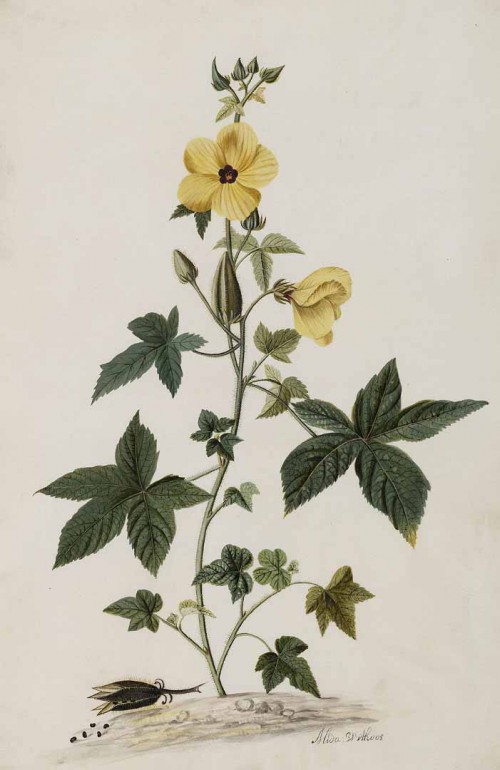Benutzer-Werkzeuge
Dies ist eine alte Version des Dokuments!
Abelmoschus moschatus Medik. - Malvaceae - syn.Hibiscus abelmoschus L.; Bamia abelmoschus R.Br. - Malvaceae
musk okra, musk mallow, tropical jewel-hibiscus, ambrette (fr.), Moschus-Bisameibisch
Hispid annual or biennial,1-1,25 m; grown in warm countries for the musk-fragrant seeds and the showy yellow crimson-centered axillary fls. which are about 4 in across; leaves various, usually with deep divaricate narrow strongly and irregularly toothed lobes, but some of them shallowly lobed and maple-like, all sparsely hairy on both surfaces; bracts linear, much shorter than the spathaceous many-toothed caducous calyx; fruit oblong-acuminate, hairy, 3 in. or less long.
„The seeds have a sweet, flowery, heavy fragrance similar to that of musk (hence its specific epithet moschātus, scientific Latin for ‘musk’).“
http://en.wikipedia.org/wiki/Abelmoschus_moschatus
The plant is cultivated for essential oil from the seeds, which has a musk-like odor and is used in perfumery. The seeds itself were formerly considered stimulant and antispasmodic. The tincture and the volatile oil are widely used in cosmetics like creams, lotions and soaps and as a food flavor. The seeds contain 14.5% fatty oil and 0.2-0.6% volatile oil, starch, methionine sulfoxide and phospholipids. Main constituents of the semisolid pale yellow volatile oil, extracted by steam distillation, are farnesol (42.3%) and ambrettolide (14.8%, omega-6-hexadecenlactone, lactone of ambrettolic acid), which isresponsible for the musk-like odor.
[Extraction of ambrette seed oil and isolation of ambrettolide with its characterization by 1H NMR., Nautiyal, O.H., Tiwari, K.K., J. Nat. Prod, Vol.4, 2011, 75-80]
http://journalofnaturalproducts.com/Volume4/12_Res_paper-11.pdf
„The essential oil from ambrette seeds (Hibiscus abelmoschus L. syn. Abelmoschus moschatus, Moerich) has long been used in the perfumery industry. The essential oil is localized mainly in the seed coat that cannot be easily separated from the kernel. Different methods of separation of the seed coat have been attempted, and none of the methods has been found to be satisfactory. A method for its selective extraction with alcoholic solvents and purification is described. A fragrant extract free from fatty acids and fatty oil, which is superior to the steam-distilled product is obtained in improved yields.“
[A Novel Process for the Extraction of Fragrance Components from Ambrette (Hibiscus abelmoschus L.) Seeds. P. K. Rout , K. C. Barik , K. S. Jena , D.Sahoo, and Y. R. Rao, Org. Proc. Res. Dev., 2002, 6 (4), pp 401–404]
http://cdn-pubs.acs.org/doi/abs/10.1021/op0200017

Hibiscus moschatus (Medik.) Salisb. as Abelmoschus moschatus Medik.
Moninckx, J., Moninckx atlas, vol.4 t.25 (1682-1709)
http://www.plantillustrations.org/species.php?id_species=508
